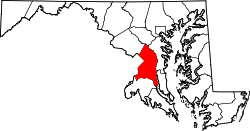External links
- Nottingham Site, Prince George's County, Inventory No.: PG:82B-25, including photo in 1974, at Maryland Historical Trust website
- M-NCPPC Inventory of Historic Sites (Prince George's County): Archeological Sites; National Archives Archeological Site, entry 82B-025, p. 205
| Topics |   | |
|---|---|---|
| Lists by county | ||
| Lists by city | ||
| Other lists | ||
Native Americans in Maryland | |
|---|---|
| Historical and present tribes | |
| Historical languages | |
| Present territories | |
| Historic figures | |
| Historical communities | |
| Precontact peoples | |
| Precontact communities |
|
| Other precontact sites | |
| Institutions | |
| Other topics | |
This article about a Registered Historic Place in Prince George's County, Maryland is a stub. You can help Wikipedia by expanding it. |
